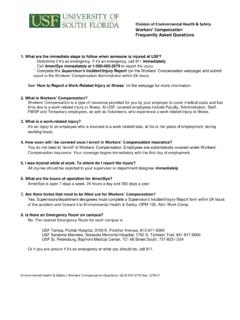Transcription of The Sequential Intercept Model - University of South Florida
1 THE Sequential Intercept MODELA dvancing Community-Based Solutions for Justice-Involved People with Mental and Substance Use DisordersThe Sequential Intercept ModelKey Issues at Each InterceptIntercept 0 Mobile crisis outreach teams and co-responders. Behavioral health practitioners who can respond to people experiencing a behavioral health crisis or co-respond to a police Department diversion. Emergency department (ED) diversion can consist of a triage service, embedded mobile crisis, or a peer specialist who provides support to people in crisis. Police-friendly crisis services.
2 Police officers can bring people in crisis to locations other than jail or the ED, such as stabilization units, walk-in services, or 1 Dispatcher training. Dispatchers can identify behavioral health crisis situations and pass that information along so that Crisis Intervention Team officers can respond to the police responses. Police officers can learn how to interact with individuals experiencing a behavioral health crisis and build partnerships between law enforcement and the with super-utilizers and providing follow-up after the crisis. Police officers, crisis services, and hospitals can reduce super-utilizers of 911 and ED services through specialized 2 Screening for mental and substance use disorders.
3 Brief screens can be administered universally by non-clinical staff at jail booking, police holding cells, court lock ups, and prior to the first court appearance. Data matching initiatives between the jail and community-based behavioral health providers. Pretrial supervision and diversion services to reduce episodes of incarceration. Risk-based pre-trial services can reduce incarceration of defendants with low risk of criminal behavior or failure to appear in court. Intercept 3 Treatment courts for high-risk/high-need individuals. Treatment courts or specialized dockets can be developed, examples of which include adult drug courts, mental health courts, and veterans treatment programming and health care services.
4 Jail health care providers are constitutionally required to provide behavioral health and medical services to detainees needing with the Veterans Justice Outreach specialist from the Veterans Health Administration. Intercept 4 Transition planning by the jail or in-reach providers. Transition planning improves reentry outcomes by organizing services around an individual s needs in advance of release. Medication and prescription access upon release from jail or prison. Inmates should be provided with a minimum of 30 days medication at release and have prescriptions in hand upon hand-offs from corrections to providers increases engagement in services.
5 Case managers that pick an individual up and transport them directly to services will increase positive 5 Specialized community supervision caseloads of people with mental disorders. Medication-assisted treatment for substance use disorders. Medication-assisted treatment approaches can reduce relapse episodes and overdoses among individuals returning from to recovery supports, benefits, housing, and competitive employment. Housing and employment are as important to justice-involved individuals as access to behavioral health services. Removing criminal justice-specific barriers to access is critical.
6 Intercept 5 Community CorrectionsParoleProbationCOMMUNITYV iolationViolationIntercept 4 ReentryJail ReentryPrison ReentryIntercept 3 Jails/CourtsSpecialty CourtDispositional CourtJailIntercept 2 Initial Detention/Initial Court HearingsInitial DetentionFirst CourtAppearanceCrisis LinesCrisis CareContinuumIntercept 0 Community ServicesCOMMUNITYI ntercept 1 Law Enforcement911 ArrestLocal LawEnforcementHistory and Impact of the Sequential Intercept ModelThe Sequential Intercept Model (SIM) was developed over several years in the early 2000s by Mark Munetz, MD and Patricia A.
7 Griffin, PhD, along with Henry J. Steadman, PhD, of Policy Research Associates, Inc. The SIM was developed as a conceptual Model to inform community-based responses to the involvement of people with mental and substance use disorders in the criminal justice system. After years of refinement and testing, several versions of the Model emerged. The linear depiction of the Model found in this publication was first conceptualized by Dr. Steadman of PRA in 20041 through his leadership of a National Institute of Mental Health-funded Small Business Innovative Research (SBIR) grant awarded to PRA.
8 The linear SIM Model was first published by PRA in 20052 through its contract to operate the GAINS Center on behalf of the Substance Abuse and Mental Health Services Administration (SAMHSA). The filter and revolving door versions of the Model were formally introduced in a 2006 article in the peer-reviewed journal Psychiatric Services authored by Drs. Munetz and Griffin3. A full history of the development of the SIM can be found in the book The Sequential Intercept Model and Criminal Justice: Promoting Community Alternatives for Individuals with Serious Mental funding from the National Institute of Mental Health, PRA developed the linear version of the SIM as an applied strategic planning tool to improve cross-system collaborations to reduce involvement in the justice system by people with mental and substance use disorders.
9 Through this grant, PRA, working with Dr. Griffin and others, produced an interactive, facilitated workshop based on the linear version of the SIM to assist cities and counties in determining how people with mental and substance use disorders flow from the community into the criminal justice system and eventually return to the the mapping process, the community stakeholders are introduced to evidence-based practices and emerging best practices from around the country. The culmination of the mapping process is the creation of a local strategic plan based on the gaps, resources, and priorities identified by community its development, the use of the SIM as a strategic planning tool has grown tremendously.
10 In the 21st Century Cures Act5, the 114th congress of the United States of America identified the SIM, specifically the mapping workshop, as a means for promoting community-based strategies to reduce the justice system involvement of people with mental disorders. SAMHSA has supported community-based strategies to improve public health and public safety outcomes for justice-involved people with mental and substance use disorders through SIM Mapping Workshop national solicitations and by providing SIM workshops as technical assistance to its criminal justice and behavioral health grant programs.








